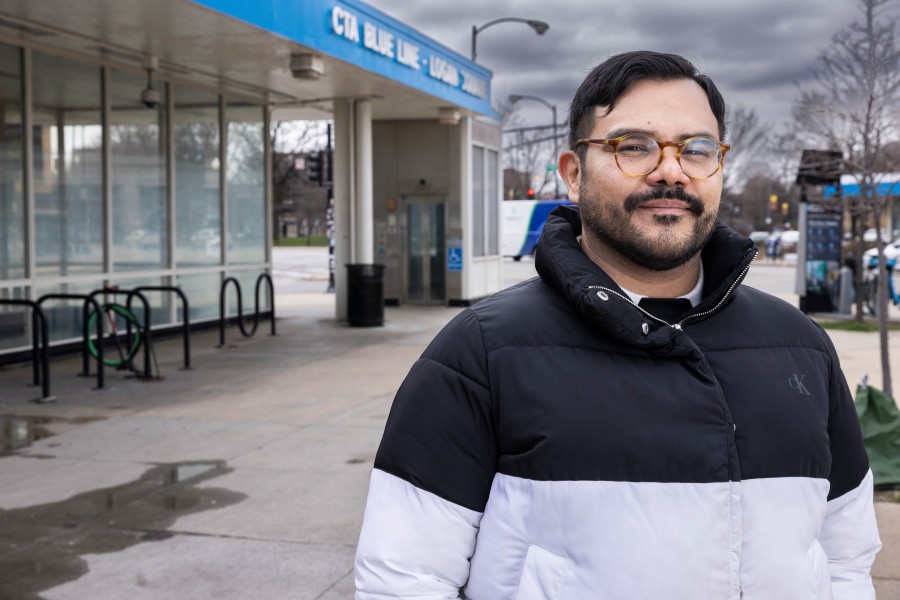An effort is underway to reclaim Logan Square with affordable housing near transit stops
Housing advocates say equitable Transit-Oriented Development can help stave off gentrification in the Northwest Side neighborhood.
By Juanpablo Ramirez-Franco

An effort is underway to reclaim Logan Square with affordable housing near transit stops
Housing advocates say equitable Transit-Oriented Development can help stave off gentrification in the Northwest Side neighborhood.
By Juanpablo Ramirez-FrancoThis coverage is made possible through a partnership between WBEZ and Grist, a nonprofit, independent media organization dedicated to telling stories of climate solutions and a just future. Sign up for WBEZ newsletters to get local news you can trust.
Christian Diaz hates a boxy, six-story brick building with colored paneling in Logan Square near the intersection of Milwaukee Ave and Spaulding Ave.
“It looks boring and uninspired,” said Diaz, the housing director at Palenque LSNA, formerly known as the Logan Square Neighborhood Association. “When people think gentrification, this is the building that comes to mind.”
The building is an example of what urban planners call Transit-Oriented Development, or TOD. The idea is that developing near transit leads to interconnected communities and fewer Carbon Dioxide-emitting cars. Developers get incentives and neighbors get a walkable community. But Diaz said buildings like this — dense, tall developments catering to wealthy tenants — are accelerating gentrification in the once working-class, largely Latino neighborhood on the near Northwest Side. Only three of the 60 units qualify as affordable housing.
“This building, thumbs down — 100% thumbs down,” Diaz said.
Instead, housing advocates like Diaz want to use TOD as a tool to make Logan Square accessible for everyone — and to help reclaim it for people pushed out by gentrification.
“The irony is that in the pursuit of more walkable cities, we’re actually making it so that people of color in general have to be more reliant on cars,” Diaz said.
As longtime residents are pushed out further and further from the city, he points out, access to public transportation becomes limited and cars become inevitable.
Diaz’s fight isn’t easy, but his group is starting to score some wins with new affordable housing and public spaces. In the end, success will mean marrying a drive for affordable housing to the increasingly clear need for sustainable and climate-resistant cities.
Transportation is the largest source of greenhouse gas emissions in the U.S. To reach government climate goals to avert severe climate impacts, urban planners and advocates say cities need to build dense neighborhoods that make public transportation a meaningful alternative to cars.
TOD as one solution picked up in earnest in Chicago around 2013 after the City Council passed an ordinance encouraging developers to build near transit. It was a race-neutral policy that resulted in little activity on the South and West sides. But off the CTA Blue Line, for example, that meant luxury housing that left out moderate- and low-income families. In 2019, the city updated the ordinance to ensure a racial analysis is baked into any project.
“We don’t want walkable neighborhoods only for affluent individuals,” said Jannice Newson, coordinator for Elevated Chicago, a coalition of nonprofits and city agencies trying to advance equity in Transit-Oriented Development — or eTOD.
TOD has thrived in hot markets, according to Kate Lowe, a professor of urban planning at the University of Illinois Chicago.
“That’s the thing,” Lowe said. “When we rely on the private sector, we’re going to see profit- driven actions.”
The market in Logan Square is hot. The price of a single-family home can cost $1 million. Upscale retail dots the Milwaukee Avenue corridor. Since 2001, nearly half of Logan Square’s Latino population has been displaced and replaced by mostly white and upwardly mobile residents. To count as affordable housing, resident incomes must be at or below 60% of the area median income. In Chicago, for a family of four that comes to $66,180.
Creating an accessible community for all
Logan Square is still gentrified, but parts of the neighborhood are becoming familiar again and more accessible. Soon the streetscape is going to be redesigned around the Logan Square Blue Line station.
“We’re gonna have more green space, we’re going to have La Placita,” Diaz said.
La Placita — Spanish for a small plaza — emerged out of conversations with residents who wanted a Latin American-inspired public square. The development is part of a traffic redesign of Milwaukee Avenue from Belmont to Kedzie Avenue. After years of planning, construction is set to begin in the coming months.
“I can’t wait, in two years, to call my mom on a Sunday morning and say, ‘Hey mom, vamos a la plazita,’ and we can just walk down the street in Logan Square,” Diaz said.
It’s not just greenspace. Palenque is also working on developing 10 murals across neighborhood schools that commemorate the history and culture of the neighborhood.
“As we’re developing this new open, walkable space for the community, our hope is that the children will eventually come to La Placita and say, ‘Oh, wow, that’s the mural from my school. This plaza is for me.’ ”
Diaz is proud of the work his organization and other local partners have accomplished. He said it’s proof that it’s possible to fight — and possible to win.
“We’re here to stay part of the neighborhood,” Diaz said. “A significant part of the neighborhood, especially in the center, along the Logan Square Blue Line station, will always be working-class people and people of color.”
Right near where La Plazita will sit, Diaz fixed his glasses and pointed toward a modern, seven-story building. On a former parking lot, an eTOD development called the Lucy Gonzalez Parsons apartment building has 100 units — all affordable housing.
“This one gets two thumbs up,” Diaz said.
Juanpablo Ramirez-Franco covers climate change and the environment for WBEZ and Grist. Follow him on X at @__juanpab.